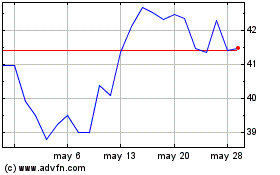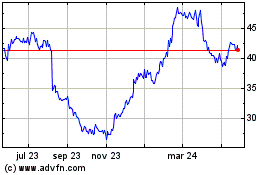Ahead of Wall Street - July 31, 2012 - Ahead of Wall Street
31 Julio 2012 - 4:05AM
Zacks
Tuesday, July 31, 2012
All eyes are on the U.S. Federal Reserve and the European
Central Bank as the two critical central banks hold their regular
scheduled meetings this week. The Fed’s two-day meeting starts
today and the official statement comes out Wednesday afternoon,
ahead of Friday’s key July jobs report. The consensus expectation
seems to be that the Fed will not announce anything new on
Wednesday, leaving any major policy changes to the September
meeting.
But pressure will be high on Mario Draghi, the ECB president, to
follow through on his ‘whatever it takes’ statement from last week.
Mr. Draghi’s statement has raised hopes that the ECB will start
purchasing Spanish (and Italian) government bonds whose rising
yields lately have stoked fears that the country may need a bailout
of its own. But Mr. Draghi heads a divided house, where Germany
remains opposed to any such move, making it difficult to reconcile
Germany’s concerns with Spain’s needs and the market’s demands.
But beyond what the Fed and the ECB may or may not do this week is
the more fundamental question of whether monetary policy tools are
even relevant to the issues facing these two key economies. The
answer is far from clear on that count, particularly with respect
to the Fed who has done more than any other major central bank to
do its job. But with election-year politics making it difficult to
address the core fiscal issues confronting the U.S economy, the Fed
may decide it preferable to be seen to be ‘doing something’.
Many serious market watchers even remain of the opinion that the
economy’s condition is not precarious enough to warrant fresh Fed
support. They point to last week’s 1.5% GDP growth rate in the
second quarter and expectations of 100K-plus jobs in Friday’s Jobs
report as evidence in support of this claim. This morning’s June
Personal income & Outlays reading would also fall in that
category. That may be so, but when you combine the loss of momentum
in the U.S. economy with the problems in Europe and the issues in
China, we have an almost global synchronized global slowdown that
may still have quite some ways to further down.
We are clearly seeing the impact of this global slowdown in
corporate results this earnings season, with companies finding it
difficult to achieve top-line gains. While about two-thirds of the
companies were able to beat earnings expectations – roughly in-line
with recent quarters, a far weaker percentage of about 38% are able
to come ahead of revenue expectations. Even many among these
‘revenue beaters’ are guiding towards weaker times ahead. The trend
is widespread across different sectors/industries and present in
this morning’s basket of results from Pfizer
(PFE), Coach (COH), and Goodyear
Tire (GT).
Sheraz Mian
Director of Research
COACH INC (COH): Free Stock Analysis Report
GOODYEAR TIRE (GT): Free Stock Analysis Report
PFIZER INC (PFE): Free Stock Analysis Report
To read this article on Zacks.com click here.
Zacks Investment Research
Want the latest recommendations from Zacks Investment Research?
Today, you can download 7 Best Stocks for the Next 30 Days. Click
to get this free report
Tapestry (NYSE:TPR)
Gráfica de Acción Histórica
De Jun 2024 a Jul 2024

Tapestry (NYSE:TPR)
Gráfica de Acción Histórica
De Jul 2023 a Jul 2024
